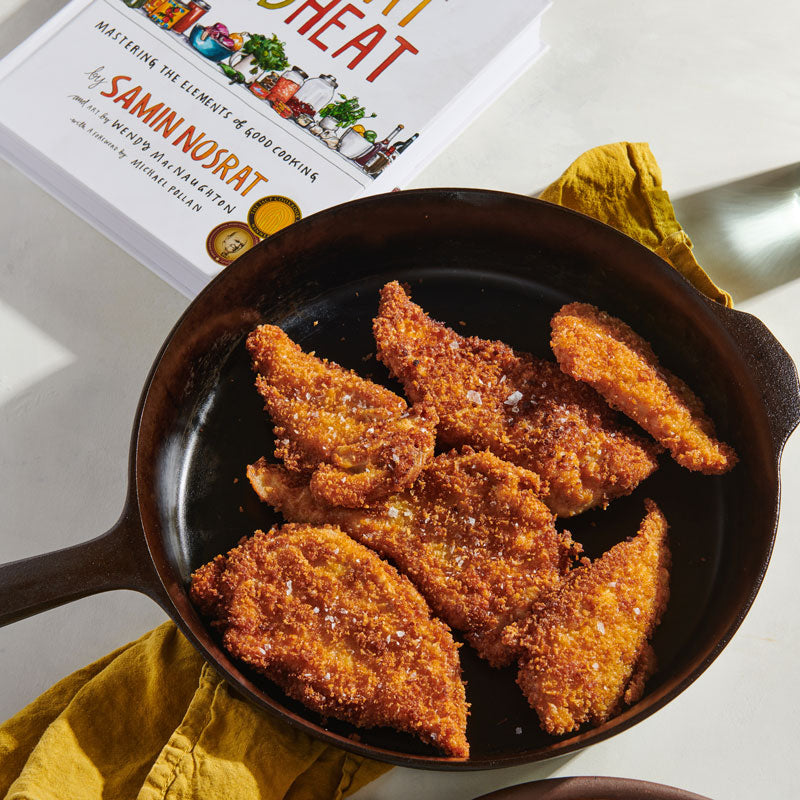Recipes
Cast Iron Pad Thai
Pad Thai is a classic dish with endless possibilities! Want to make a gluten free version? Great, swap the soy sauce for tamari or coconut aminos. Need to keep things vegan? Skip the egg and use more soy sauce in place of fish sauce. Craving something spicy? Ramp up the sriracha or add a red thai chile into the mix. Can’t find tamarind in your local grocery store? Feel free to use rice vinegar to add acidity instead. Have some extra veggies that need to get used? Dice ‘em up and add ‘em in! More traditional Thai dishes sometimes use preserved turnips or daikon radishes and dried shrimp, so those would be fun additions if you can find them. This recipe is designed as a jumping off point, with plenty of places along the way to make it your own.
While traditionally made in a wok, using a cast iron skillet for this dish allows you to get a deep sear on your protein, and provides great heat retention and distribution. And using a slotted turner allows you to move the veggies and eggs around the pan quickly, mimicking the motion of tossing vegetables in a wok.
We like a vegetable-forward version, but this recipe is quite forgiving. You could certainly omit some of the veggies or add extras that you happen to have in your fridge. Please note that you will want your veggies to be similar sizes so they cook at similar rates! We love the quick-cooking nature of the shredded/thinly sliced veggies.
Recipe: Cast Iron Pad Thai
Yield: 4 generous servings
Ingredients
- 8-10 ounces flat rice noodles
- 2 tablespoons + 1 teaspoon peanut, olive, or sesame oil
- 8 ounces chicken or extra-firm tofu, chopped into small and even cubes
- 1 red bell pepper, thinly sliced and cut into 1-inch lengths
- 2 carrots, shredded
- 3-4 green onions, chopped
- 3 cloves garlic, minced
- 1 cup fresh bean sprouts
- 1 thai red chile, optional
- 2 eggs, whisked (omit for a vegan version)
- 2/3 cup dry roasted peanuts, chopped
Other veggies to try
- Napa cabbage
- Broccoli
- Shallots
- Daikon radishes
Sauce Ingredients
- 2 Tablespoons fish sauce (or substitute more soy sauce for a vegetarian option)
- 2 Tablespoons soy sauce
- 3 Tablespoons brown sugar
- 2 Tablespoons Thai Tamarind Paste (or substitute rice vinegar if you can’t find tamarind)
- 1 Tablespoon Sriracha (or more to taste)
- 2 Tablespoons creamy peanut butter
- 1 Tablespoon lime juice
Garnish Options
- Lime wedges
- Chopped cilantro or basil leaves
- Chili flakes
- Extra bean sprouts
- Extra sriracha
- Extra green onions
- Extra dry roasted peanuts
Tools
No.10 Field Skillet
Field Slotted Turner or Wooden Spatula
Resources
The Field Method for Cast Iron Care
Instructions
Cook your noodles according to the directions on the package (usually 3-4 min). Rinse under cold water to keep them from sticking/cooking further.
Make your sauce by whisking sauce ingredients together in a bowl.
Increase heat to medium high and add 1 tablespoon of your preferred oil.
Add the tofu or chicken. Cook chicken until cooked through (3-5 minutes) or sear tofu until it is lightly browned on all sides (approx. 2 minutes/side). Remove protein from skillet and set aside.
Add another tablespoon of oil and allow it to heat up. Add green onion, red pepper, garlic, bean sprouts and carrots to the skillet. Stir frequently for about 3 minutes or until the veggies are crisp tender.
Push veggies to the sides of the pan and add about a teaspoon of oil to the center. Add the beaten eggs, and break them into small pieces with your slotted turner as they cook.
Remove skillet from heat. Cast iron has great heat retention, so your pad thai will stay warm even after it’s removed from the burner.
Add noodles, sauce, protein and peanuts to the pan. Toss everything to combine.
Garnish the top with your preferred extras! Serve straight from your skillet with lime wedges.
Seasoning Rating: Safe
A well-seasoned cast iron skillet handles acidic ingredients just fine, so cooking this dish in your Field skillet shouldn’t have much of an impact on your well-established seasoning. And because you are adding seasoning to your pan while cooking the protein and veggies and simply adding in the acidic ingredients at the end, this also lessens the impact.
Serving straight from the pan will keep your food nice and warm, but we would recommend cleaning things up right after dinner and following the Field Method to keep your cast iron in good shape!
Seasoning Ratings:
Best—These dishes are the best options for building resilient seasoning, and surefire choices for getting tricky pans back on track.
Better—The best way to keep your skillet in great shape is to cook frequently, and cast iron-friendly dishes like these are your bread and butter.
Safe—These recipes won't strip seasoning away from your pan, but won't really add any, either.
OK—Be sure to clean up promptly. Recipes with this rating might feature acidic ingredients which can affect seasoning if not washed soon after cooking.




